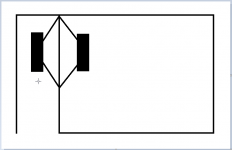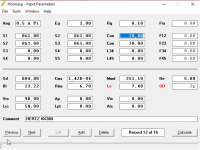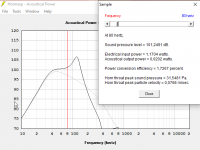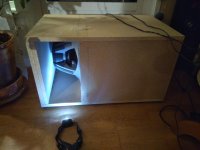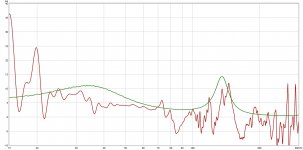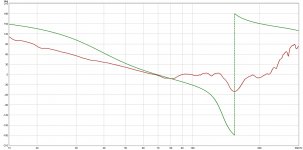My son got a request to build a suitable box for two Hertz HX380 15 inch drivers. The challange being getting two 0,41 Qts, 130 liter Vas drivers into a box not exceeding 810 X 500 X 480 mm (194,4 liter).
I appreciate bassreflex just about as much as root canal work without anesthesia or dog poo on my hamburger, so that kind of excludes that option.
A straight run of the mill closed box lacks any real midbass punch with this kind of drivers, and any kind of tapped horn or higher order BP ended up at least twice the maximum allowable size.
I have never built a 4th order bandpass before and I like the PPSL type of box, since they tend to sound very punchy, clean and "alive" if done right.
After a few hours of Hornresp backed meditations on the problem I came up with this quite simple to build layout.
We choose isobaric loading to get some real useful Bl to drive the short quarter wave front resonator and to help pressureize the car cabin even at high power levels. The huge Le and high Qts tends to dull and muffle the midbass response when pushing some real power into the driver. Isobaric loading doubles the Bl and doubles the power dissipation capacity of the voicecoils and keeps distortion at bay when needed the most.
I appreciate bassreflex just about as much as root canal work without anesthesia or dog poo on my hamburger, so that kind of excludes that option.
A straight run of the mill closed box lacks any real midbass punch with this kind of drivers, and any kind of tapped horn or higher order BP ended up at least twice the maximum allowable size.
I have never built a 4th order bandpass before and I like the PPSL type of box, since they tend to sound very punchy, clean and "alive" if done right.
After a few hours of Hornresp backed meditations on the problem I came up with this quite simple to build layout.
We choose isobaric loading to get some real useful Bl to drive the short quarter wave front resonator and to help pressureize the car cabin even at high power levels. The huge Le and high Qts tends to dull and muffle the midbass response when pushing some real power into the driver. Isobaric loading doubles the Bl and doubles the power dissipation capacity of the voicecoils and keeps distortion at bay when needed the most.
Attachments
Here is a picure of the build. I hope I can post some measurements later.
The grey curve in the Hornresp SPL simulation above is the pure closed box response without the short QW front resonator.
There is quite an increase in midbass output even from this very short QW front resonator. I would have made it longer if I could, but I did not want to fold it since that often introduces a lot of higher order harmonics due to reflections inside the resonator.
The grey curve in the Hornresp SPL simulation above is the pure closed box response without the short QW front resonator.
There is quite an increase in midbass output even from this very short QW front resonator. I would have made it longer if I could, but I did not want to fold it since that often introduces a lot of higher order harmonics due to reflections inside the resonator.
Attachments
Here is the simulation compared to a measurement of the box laying on my living room floor and with the Umik very close to the mouth of the front resonator.
Spl, Group Delay and Phase.
I don't think the stated specs of the drivers are correct, and there might be some small leak around the flange of the driver. It is made of plastic and we had a hard time tightening them down without warping the driver flange. We used a lot of hot glue around the parameter.
It does tend to sound nice though. It is clean, punchy and plenty loud. The car cabin room gain flattens the response downward, but it is a little rolled of below 40 Hz. Nothing that some EQ can not fix, but without EQ it sounds a little light weight. It does have some horn character with a very snappy and punchy midbass and a quite physical and tactile reproduction, making drums sound very live and entertaining.
Spl, Group Delay and Phase.
I don't think the stated specs of the drivers are correct, and there might be some small leak around the flange of the driver. It is made of plastic and we had a hard time tightening them down without warping the driver flange. We used a lot of hot glue around the parameter.
It does tend to sound nice though. It is clean, punchy and plenty loud. The car cabin room gain flattens the response downward, but it is a little rolled of below 40 Hz. Nothing that some EQ can not fix, but without EQ it sounds a little light weight. It does have some horn character with a very snappy and punchy midbass and a quite physical and tactile reproduction, making drums sound very live and entertaining.
